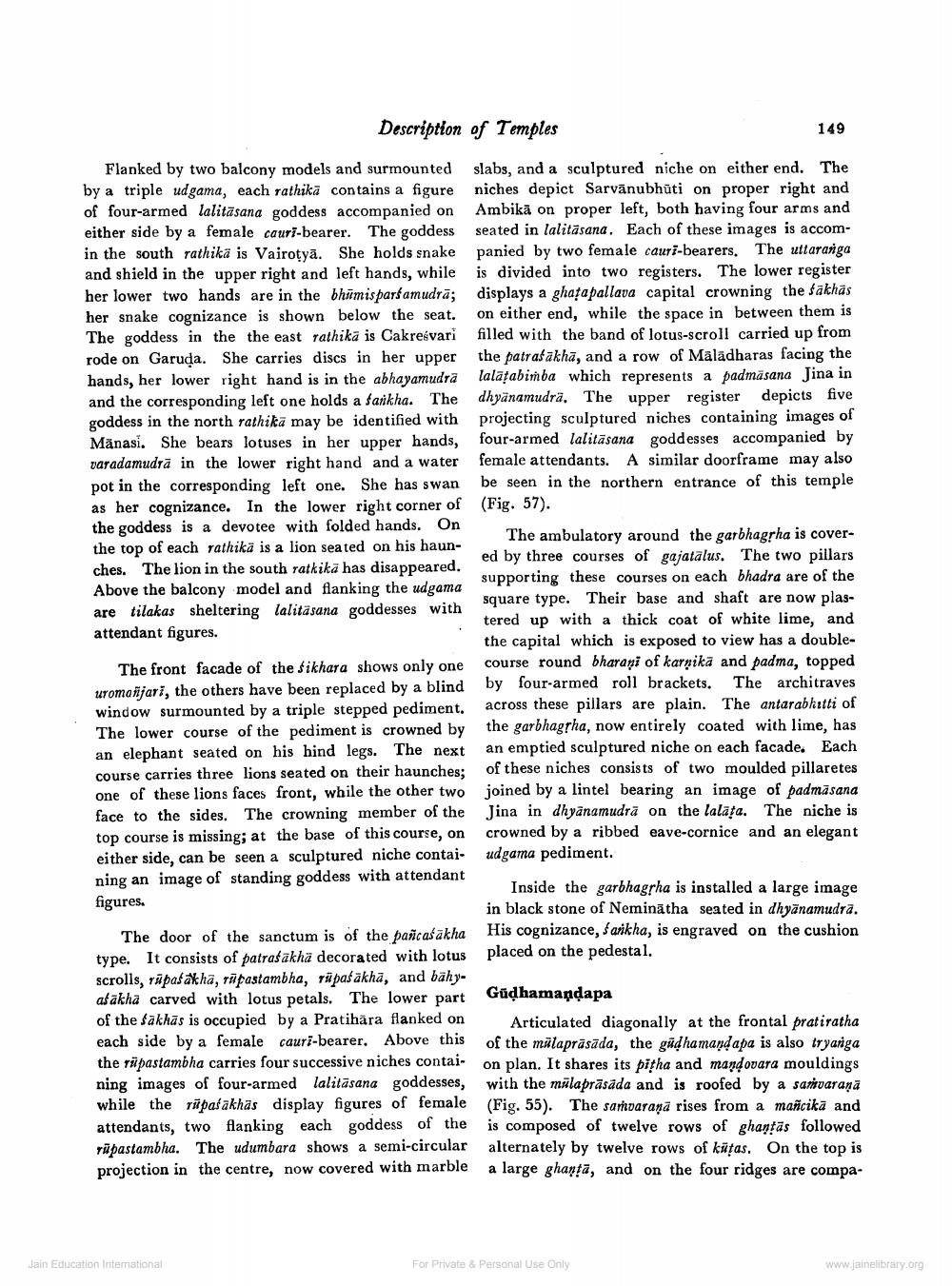________________
Description of Temples
149
Flanked by two balcony models and surmounted slabs, and a sculptured niche on either end. The by a triple udgama, each rathika contains a figure niches depict Sarvānubhūti on proper right and of four-armed lalitāsana goddess accompanied on Ambika on proper left, both having four arms and either side by a female cauri-bearer. The goddess seated in lalitasana. Each of these images is accomin the south rathika is Vairotyä. She holds snake panied by two female cauri-bearers. The uttaranga and shield in the upper right and left hands, while is divided into two registers. The lower register her lower two hands are in the bhūmisparsamudrā; displays a ghata pallava capital crowning the sākhas her snake cognizance is shown below the seat on either end, while the space in between them is The goddess in the the east rathika is Cakresvari filled with the band of lotus-scroll carried up from rode on Garuda. She carries discs in her upper the patrašakha, and a row of Maladharas facing the hands, her lower right hand is in the abhayamudra lalațabimba which represents a padmasana Jina in and the corresponding left one holds a Saikha. The dhyānamudra. The upper register depicts five goddess in the north rathika may be identified with projecting sculptured niches containing images of Mānasi. She bears lotuses in her upper hands, four-armed lalitāsana goddesses accompanied by varadamudra in the lower right hand and a water female attendants. A similar doorframe may also pot in the corresponding left one. She has swan be seen in the northern entrance of this temple as her cognizance. In the lower right corner of (Fig. 57). the goddess is a devotee with folded hands. On the top of each rathika is a lion seated on his haun
The ambulatory around the garbhagyha is coverches. The lion in the south ratkika has disappeared.
ed by three courses of gajatālus. The two pillars Above the balcony model and flanking the udgama
supporting these courses on each bhadra are of the are tilakas sheltering lalitasana goddesses with
square type. Their base and shaft are now plasattendant figures.
tered up with a thick coat of white lime, and
the capital which is exposed to view has a doubleThe front facade of the fikhara shows only one course round bharayi of karnika and padma, topped uromanijari, the others have been replaced by a blind by four-armed roll brackets. The architraves window surmounted by a triple stepped pediment. across these pillars are plain. The antarabkıtti of The lower course of the pediment is crowned by the garbhagsha, now entirely coated with lime, has an elephant seated on his hind legs. The next an emptied sculptured niche on each facade. Each course carries three lions seated on their haunches; of these niches consists of two moulded pillaretes one of these lions faces front, while the other two joined by a lintel bearing an image of padmāsana face to the sides. The crowning member of the Jina in dhyānamudrä on the lalața. The niche is top course is missing; at the base of this course, on crowned by a ribbed eave-cornice and an elegant either side, can be seen a sculptured niche contai- udgama pediment. ning an image of standing goddess with attendant
Inside the garbhagrha is installed a large image figures.
in black stone of Neminātha seated in dhyanamudra. The door of the sanctum is of the pañcasakha His cognizance, $arikha, is engraved on the cushion type. It consists of patrašakha decorated with lotus placed on the pedestal. scrolls, rāpasakha, rafastambha, räpasākha, and bähyafakha carved with lotus petals. The lower part Gudhamandapa of the fakkās is occupied by a Pratihära flanked on
Articulated diagonally at the frontal pratiratha each side by a female cauri-bearer. Above this of the milaprāsāda, the güdhamandapa is also tryaniga the räpastambha carries four successive niches contai- on plan. It shares its pitha and mandovara mouldings ning images of four-armed lalitasana goddesses, with the mülaprāsada and is roofed by a sanaraņā while the ripasakhas display figures of female (Fig. 55). The samvaraṇa rises from a mañcika and attendants, two flanking each goddess of the is composed of twelve rows of ghantās followed rūpastambha. The udumbara shows a semi-circular alternately by twelve rows of kāțas. On the top is projection in the centre, now covered with marble a large ghanta, and on the four ridges are compa
Jain Education International
For Private & Personal Use Only
www.jainelibrary.org




